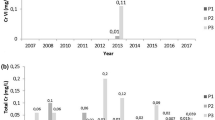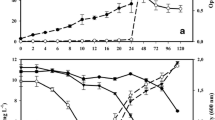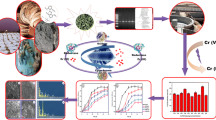Abstract
A native bacterial strain with high capability for Cr (VI) removal was isolated from tannery sediments located in Elena (Córdoba Province, Argentina). The strain was characterized by amplification of 16S rRNA gene and identified as Serratia sp. C8. It was able to efficiently remove different Cr (VI) concentrations in a wide range of pHs and temperatures. The addition of different carbon sources as well as initial inoculum concentration were analyzed, demonstrating that Serratia sp. C8 could reduce 80 % of 20 mg/L Cr (VI) in a medium containing glucose 1 g/L, at pH 6–7 and 28 °C as optimal conditions, using 5 % inoculum concentration. The mechanisms involved in Cr (VI) removal were also evaluated. The strain was capable of biosorpting around 7.5–8.5 % of 20 mg/L Cr on its cell surface and to reduce Cr (VI). In addition, approximately a 54 and 46 % of total Cr was detected in the biomass and in the culture medium, respectively, and in the culture medium, Cr (III) was the predominant species. In conclusion, Serratia sp. C8 removed Cr (VI) and the mechanisms involved in decreasing order of contribution were as follows: reduction catalyzed by intracellular enzymes, accumulation into the cells, and biosorption to the microbial biomass. This strain could be a suitable microorganism for Cr (VI) bioremediation of tannery sediments and effluents or even for other environments contaminated with Cr.




Similar content being viewed by others
References
Ahluwalia SS, Goyal D (2007) Microbial and plant derived biomass for removal of heavy metals from waste water. Bioresour Technol 98:2243–2257
Altschul SF, Madden TL, Schäffer AA, Zhang J, Zhang Z, Miller W, Lipman DJ (1997) Gapped BLAST and PSI-BLAST: a new generation of protein database search programs. Nucleic Acids Res 25:3389–3402
APHA (1998) (American Public Health Association), AWWA (American Water Works Association) and WEF (American Environment Federation) Standard methods for the examination of water and wastewaters (20th Ed.), Washington DC, USA
Bae WC, Lee HK, Choe YC, Jahng DJ, Lee SH, Kim SJ, Lee JH, Jeong BC (2005) Purification and characterization of NADPH-dependent Cr(VI) reductase from Escherichia coli ATCC 33456. J Microbiol 43:21–27
Beadregard DA, Yong P, Macaskie LF, Johns ML (2010) Using non invasive magnetic resonance imaging (MRI) to assess the reduction of Cr(VI) using a biofilm-palladium catalyst. Biotechnol Bioeng 107:11–20
Benazir JF, Suganthi R, Rajvel D, Pooja MP, Mathithumilan B (2010) Bioremediation of chromium in tannery effluent by microbial consortia. Afr J Biotechnol 9(21):3140–3143
Bopp LH, Ehrlich HL (1988) Chromate resistance and reduction in Pseudomonas fluorescens strain LB 300. Arch Microbiol 150:426–431
Chandra R, Bharagava RN, Kapley A, Purohit HJ (2011) Bacterial diversity, organic pollutants and their metabolites in two aeration lagoons of common effluent treatment plant (CETP) during the degradation and detoxification of tannery wastewater. Bioresour Technol 102:2333–2341
Chaturvedi MK (2011) Studies on chromate removal by chromium-resistant Bacillus sp. isolated from tannery effluent. J Environ Prot 2:76–82
Chen Z, Huang Z, Cheng Y, Pan D, Pan X, Yu M, Pan Z (2012) Cr(VI) uptake mechanism of Bacillus cereus. Chemosphere 87(3):211–216
Cheung KH, Gu JD (2007) Mechanism of hexavalent chromium detoxification by microorganisms and bioremediation application potential: a review. Int Biodeterior Biodegrad 59:8–15
Cheung KH, Lai HY, Gu JD (2006) Membrane-associated hexavalent chromium reductase of Bacillus magaterium TK W3 with induced expression. J Microbiol Biotechnol 16:855–862
Desai C, Jain K, Madamwar D (2008) Hexavalent chromate reductase activity in cytosolic fractions of Pseudomonas sp. G1DM21 isolated from Cr (VI) contaminated industrial landfill. Process Biochem 43:713–721
Dey S, Paul AK (2012) Optimization of cultural conditions for growth associated chromate reduction by Arthrobacter sp. SUK 1201 isolated from chromite mine overburden. J Hazard Mater 213–214:200–206
El-Shafey EI (2005) Behaviour of reduction-sorption of chromium (VI) from an aqueous solution on a modified sorbent from Rice Husk. Water Air Soil Pollut 163:81–102
Esmaeili A, Nia AM, Vazirinejad R (2005) Chromium (III) removal and recovery from tannery wastewater by precipitation process. Am J Appl Sci 2(10):1471–1473
Essahale A, Malki M, Marin I, Moumni M (2012) Hexavalent chromium reduction and accumulation by Acinetobacter AB1 isolated from Fez Tanneries in Morocco. Indian J Microbiol 52(1):48–53
Farag S, Zaki S (2010) Identification of bacterial strains from tannery effluent and reduction of hexavalent chromium. J Environ Biol 31(5):877–882
Focardi S, Pepi M, Focardi SE (2013) Microbial reduction of hexavalent chromium as a mechanism of detoxification and possible bioremediation applications. In: Chamy R, Rosenkranz F (eds) Agricultural and biological sciences, biodegradation-life of science. Vol 12, pp 321-347
Gadd GM (1988) Accumulation of metal by microorganisms and algae. In: Rehm H (ed) Biotechnology: a comprehensive complete treatise, vol 6B, special microbial process, vol 4. Verlagsgesellschaft, Weinheim, pp 401–403
Garg SK, Tripathi M, Srinath T (2012) Strategies for chromium bioremediation of tannery effluent. In: Whitacre DM (ed) Reviews of environmental contamination and toxicology. Springer, Berlin, p 217
Hafez AI, El-Manharawy MS, Khedr MA (2002) RO membrane removal of unreacted chromium from spent tanning effluent. Desalination 144(1–3):237–242
Iftikhar S, Faisal M, Hasnain S (2007) Cytosolic reduction of toxic Cr(VI) by indigenous microorganisms. Res J Environ Sci 1:77–81
Li K, Ramakrishna W (2011) Effect of multiple metal resistant bacteria from contaminated lake sediments on metal accumulation and plant growth. J Hazard Mater 189:531–539
Mabbett AN, Macaskie LE (2001) A novel isolate of Desulfovibrio sp. With enhanced ability to reduce Cr(VI). Biotechnol Lett 23:683–687
Madigan TM, Martinko MJ, Parker J, Brock TD (2004) Biology of microorganisms, 10ma edition. Ed Pearson Prentice Hall 6:158–170
Mangaiyarkarasi MS, Vincent S, Janarthanan S (2011) Bioreduction of Cr(VI) by alkaliphilic Bacillus subtilis and interaction of the membrane groups. Saudi J Biol Sci 18:157–167
Mohan D, Pittman CU (2006) Activated carbons and low cost adsorbents for remediation of tri- and hexavalent chromium from water. J Hazard Mater 137(2):762–811
Oliveira H (2012) Chromium as an environmental pollutant: insights on induced plant toxicity. J Bot 2012:1–8
Pajor F, Póti P, Bodnár Á, Bárdos L (2012) Accumulation of some heavy metals (Pd, Cd and Cr) in milk of grazing sheep in north-east Hungary. J Microbiol Biotechnol Food Sci 2(1):389–394
Polti M, Amoroso MJ, Abate CM (2010) Intracellular chromium accumulation by Streptomyces sp. MC1. Water Air Soil Pollut 214:49–57
Quintelas C, Fonseca B, Silva B, Figueiredo H, Tavares T (2009) Treatment of chromium (VI) solutions in a pilot-scale bioreactor through a biofilm of Arthrobacter viscosus supported on GAC. Bioresour Technol 100(1):220–226
Rajendran R, Karthik Sundaram S, Sridevi BV, Prabhavathi P, Gopi V (2012) Biodetoxification of azo dye containing textile effluent through adapted fungal strains. J Environ Sci Technol 5:29–41
Romero CH, Pellerano RG, Acevedo HA, Vázquez FA (2006) Standarization of preliminary conditions for chromium determination in environment samples. Universidad Nacional del Nordeste, Cientific and technology comunication 2006
Sau GB, Chatterjee S, Mukherjee SK (2010) Chromate reduction by cell-free extract of Bacillus firmus KUCr1. Pol J Microbiol 59(3):185–190
Smutok O, Broda D, Smutok H, Dmytruk K, Gonchar M (2011) Chromate-reducing activity of Hansenula polymorpha recombinant cells over-producing flavocytochrome b2. Chemosphere 83(4):449–454
Song H, Liu Y, Xu W, Zeng G, Aibibu N, Xu L, Chen B (2009) Simultaneous Cr (VI) reduction and phenol degradation in pure cultures of Pseudomonas aeruginosa CCTCC AB91095. Bioresour Technol 100(21):5079–5084
Soni SK, Singh R, Awasthi A, Singh M, Kalra A (2012) In vitro Cr (VI) reduction by cell-free extracts of chromate-reducing bacteria isolated from tannery effluent irrigated soil. Environ Sci Pollut Res 20(3):1661–1674
Srinath T, Verma T, Ramteke PW, Garg SK (2002) Chromium (VI) biosorption and bioaccumulation by chromate resistant bacteria. Chemosphere 48(4):427–435
Srivastava S, Thakur IS (2007) Evaluation of biosorption potency of Acinetobacter sp. for removal of hexavalent chromium from tannery effluent. Biodegradation 18(5):637–646
Tripathi M, Vikram S, Jain RK, Garg SK (2011) Isolation and growth characteristics of chromium (VI) and pentachlorophenol tolerant bacterial isolate from treated tannery effluent for its possible use in simultaneous bioremediation. Indian J Microbiol 51(1):61–69
Volesky B (1999) Biosorption for the next century. In: Amils R, Ballester A (eds) Biohydrometallurgy and the environment toward the mining of the 21st century. Elsevier, Amsterdam, pp 161–170
Wang P, Mori T, Komori K, Ohtake H (1989) Isolation and characterization of an Enterobacter cloacae strain that reduces hexavalent chromium under anaerobic conditions. Appl Environ Microbiol 55:1665–1669
Zhang K, Li F (2011) Isolation and characterization of a chromium-resistant bacterium Serratia sp. Cr-10 from chromate-contaminated site. Appl Microbiol Biotechnol 90:1163–1169
Acknowledgments
P.S.G, M.A.T, and E.A. are members of the research career from Consejo Nacional de Investigaciones Científicas y Técnicas (CONICET) (Argentina). L.F.A and C.E.P have a fellowship from CONICET. We wish to thank PPI (SECyT-UNRC), CONICET, PICT (FONCyT), and MinCyT Córdoba for the financial support.
Author information
Authors and Affiliations
Corresponding author
Additional information
Responsible editor: Robert Duran
Rights and permissions
About this article
Cite this article
González, P.S., Ambrosio, L.F., Paisio, C.E. et al. Chromium (VI) remediation by a native strain: effect of environmental conditions and removal mechanisms involved. Environ Sci Pollut Res 21, 13551–13559 (2014). https://doi.org/10.1007/s11356-014-3311-z
Received:
Accepted:
Published:
Issue Date:
DOI: https://doi.org/10.1007/s11356-014-3311-z




